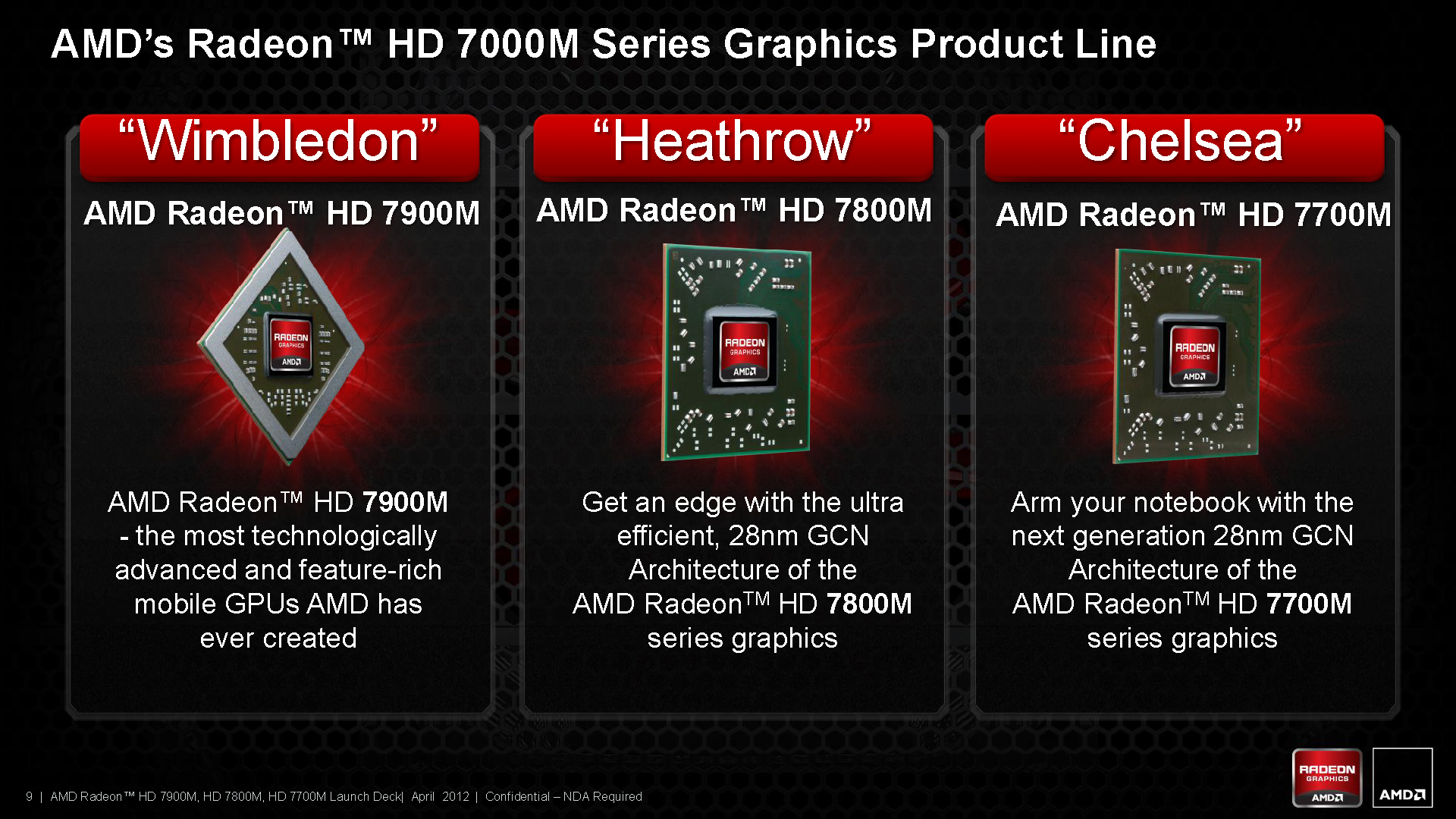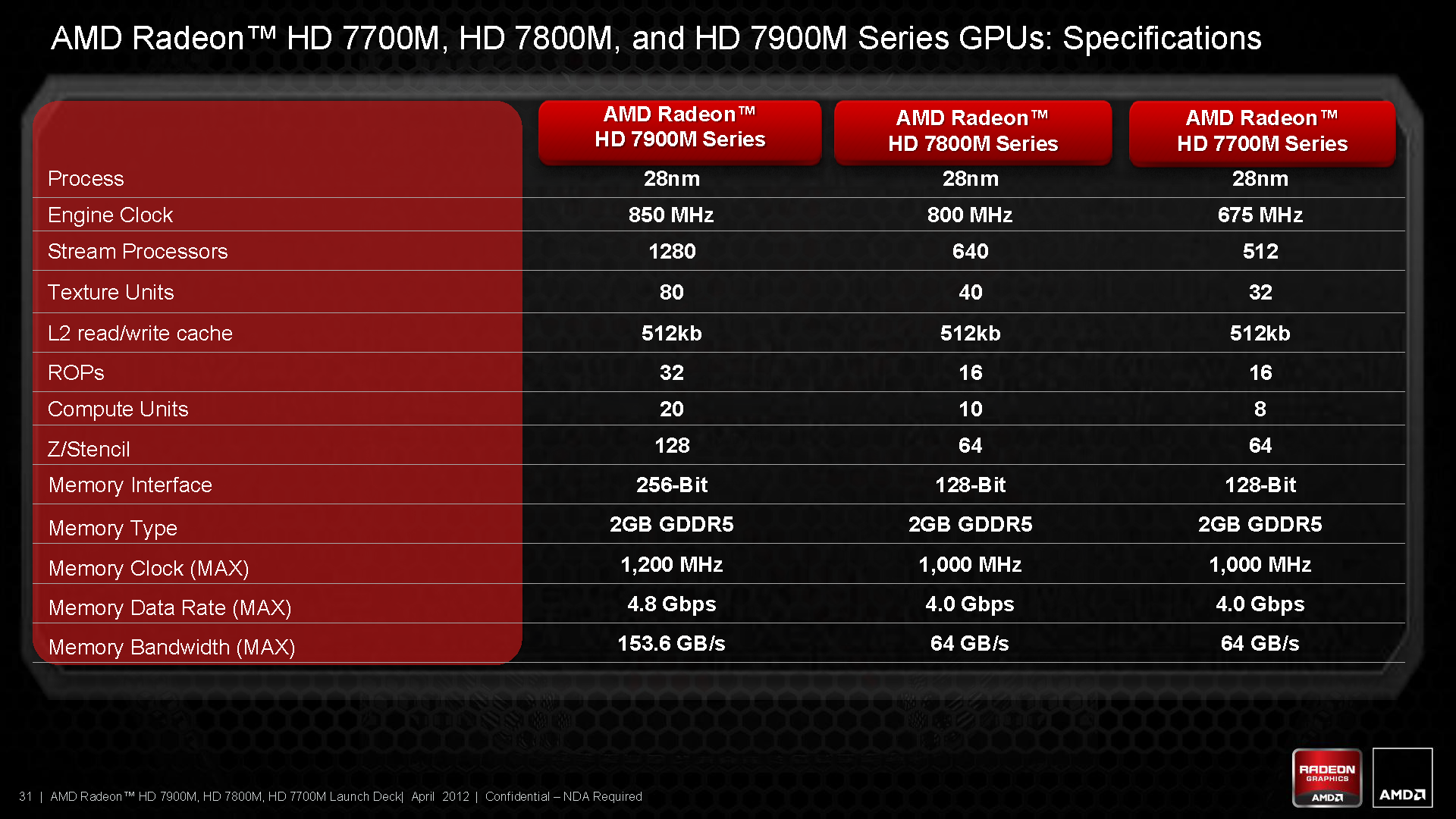AMD Launches HD 7700M, 7800M, and 7900M Mobile GPUs
AMD has launched its Radeon HD 7700M, HD 7800M, and HD 7900M mobile GPUs based its new 28 nm GCN Architecture.
Starting in late 2011, AMD has released three different series of discrete graphics cards based on its new 28 nm GCN Architecture: Radeon HD 7900 series, HD 7800 series and HD 7700 series. Now AMD has taken the new 28 nm GCN Architecture to its mobile platform with its Radeon HD 7900M "Wimbledon", HD 7800M "Heathrow" and HD 7700M "Chelsea" release.
Taking a closure look at the HD 7000M series, we start with the HD 7900M series. Users will notice the HD 7900M has basically the same specifications at the HD 7870 GPU, except with the GPU clocked at 850 MHz versus 1 GHz of the HD 7870. The HD 7970M packs 1280 GCN stream processors, 80 TMUs, 32 ROPs, and 2 GB GDDR5 memory with a 256-bit memory interface. Its core is clocked at 850 MHz, with 1200 MHz (4.80 GHz GDDR5 effective) memory clock speed, amounting to 153.6 GB/s memory bandwidth. The HD 7800M is clocked at 800 MHz, with 1000 MHz (4.0 GHz GDDR5 effective) memory clock speed, amounting to 64 GB/s memory bandwidth. It features 640 GCN stream processors, 40 TMUs, 16 ROPs, and 2 GB GDDR5 memory with a 128-bit memory interface. The HD 7700M is clocked at 675 MHz, with 1000 MHz (4.0 GHz GDDR5 effective) memory clock speed, amounting to 64 GB/s memory bandwidth. It features 512 GCN stream processors, 32 TMUs, 16 ROPs, and 2 GB GDDR5 memory with a 128-bit memory interface. The HD 7900M and HD 7800M has PCIe 3.0 support, while the HD 7700M only offers PCIe 2.0 support.
AMD has provided us with some reference performance charts that show the potential of its new HD 7000M Series. The first chart shows the performance increase of the HD 7900M versus its current gen HD 6990M. In review of the chart, the HD 7900M shows roughly a 44% improvement over the HD 6990M. In the second chart, AMD shows the Tessellation performance of the HD 7990M versus both the Nvidia GTX 675M and Radeon HD 6990M. The HD 7990 almost doubles of the performance of the GTX 675M and is nearly 8-times the performance of the HD 6990M (based on TessMark benchmark). The third chart shows the HD 7000M's performance increases you can see over the CPU alone, when taking into account GPGPU and Compute (based on ComputeMark benchmark).
| AMD Reference Performance Charts |
|---|
The HD 7000M series all feature three key elements, GCN, AMD's Enduro Technology and AMD's App Acceleration. In our initial review of the Radeon HD 7970 graphics card, we provided an in-depth breakdown of AMD's Graphics Core Next Architecture, so there is no need to expand on it for the mobile version. The Enduro technology should come in very handy for mobile users concern with power consumption. It scales GPU usage and power based graphics demand. In addition, it shuts down the GPU when not need and enables it when workload demands. Combined with AMD's ZeroCore and Power Gating technology, the HD 7000M series is setting up to be a very power efficient platform.
| Three Key Elements with Radeon HD 7000M Series |
|---|
End-users should expect to see the HD 7900M series showing up in Dell's Alienware M17X soon, with the based model starting at $1,699 (price is based on cost difference of upgrade from the Nvidia GeForce GTX 660M).
Get Tom's Hardware's best news and in-depth reviews, straight to your inbox.
-
willard Hey, at least these are actually 7000 series cards for a change. I fully expected these to be rebadged 6000 series cards.Reply -
joedjnpc Where is the naming falsification? There's clearly an "M" there to differentiate the products. The 79** series represents the highest end model, why do AMD need to keep the naming and performance consistant in the move from desktop to laptop? Anyone with half a brain knows you can't get the same performance in a lappy.Reply -
matt_b eddieroolzThe naming falsification (7870 -> 7970M) continues.As confusing and as much fuss that I can put up over the eternal naming game, I do understand it. The 7970 is supposed to be the top performer (single core GPU card) for the 7000 series for desktops, so keeping the naming scheme, the 7970m is the top performer for the mobile/laptop 7000 series - all with disregard to performance. I understand the reason, but I would just rather it be HD7970 = the 7970m in performance, with the obvious tweaks for power consumption and heat output that a mobile unit must have. Gaming/apps on a laptop would be so much easier with respect to looking up system requirements and knowing that hardware naming is on the same playing field.Reply -
noobzilla771 OMG I just bought an Alienware m17x R3 last week too :( The R4s with 7970m is out with base price of $1899.Reply
I got a refurb 6990m for $1200 after taxes. Hopefully I got it for that price because it's old GPU. If refurb 7970m shows up for the same price I will shoot myself :( -
SteelCity1981 The thing i hate is the rebandage gpus. I mean if you want to talk about truly the falsification that's falsification and i'm surprised their hasn't been a class action lawsuit in regards to rebrandaging the same gpu's by fooling consumors into thinking it's a newer gen gpu when it actually isn't.Reply -
matt_b SteelCity1981The thing i hate is the rebandage gpus. I mean if you want to talk about truly the falsification that's falsification and i'm surprised their hasn't been a class action lawsuit in regards to rebrandaging the same gpu's by fooling consumors into thinking it's a newer gen gpu when it actually isn't.Anyone in the know feels the same way about the re-badging as you do here. Lucky for consumers, all of these cards mentioned in the article are the new architecture. It may be too early to make a call, but so far Nvidia seems to be taking a solid first-placed lead for re-badging this generation of GPU's - shame on both of them though.Reply -
madooo12 matt_bAs confusing and as much fuss that I can put up over the eternal naming game, I do understand it. The 7970 is supposed to be the top performer (single core GPU card) for the 7000 series for desktops, so keeping the naming scheme, the 7970m is the top performer for the mobile/laptop 7000 series - all with disregard to performance. I understand the reason, but I would just rather it be HD7970 = the 7970m in performance, with the obvious tweaks for power consumption and heat output that a mobile unit must have. Gaming/apps on a laptop would be so much easier with respect to looking up system requirements and knowing that hardware naming is on the same playing field.so if there is potential for power improvements, why not apply them for desktops?Reply
the mobile part MUST perform less to consume less power
BTW nice to see AMD focusing more on mobile stuff

